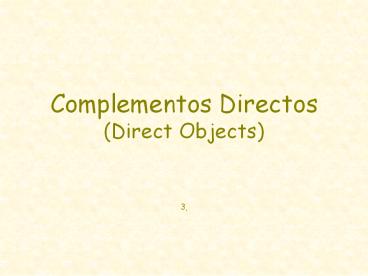Complementos Directos (Direct Objects) 3, - PowerPoint PPT Presentation
1 / 21
Title:
Complementos Directos (Direct Objects) 3,
Description:
Title: No Slide Title Author: Edmund Murphy Last modified by: Maria Hewitt Created Date: 6/20/2001 1:15:59 AM Document presentation format: On-screen Show (4:3) – PowerPoint PPT presentation
Number of Views:128
Avg rating:3.0/5.0
Title: Complementos Directos (Direct Objects) 3,
1
Complementos Directos(Direct
Objects)3,
2
What does a direct object pronoun do?
- A direct object pronoun takes the place of a
direct object. For example
Do you see the truck?
direct object
Yes, I see it.
direct object pronoun
index
3
What does a direct object pronoun do?
- A direct object pronoun takes the place of a
direct object. For example
Do you have the books?
direct object
Yes, I have them.
direct object pronoun
index
4
What does a direct object pronoun do?
- A direct object pronoun takes the place of a
direct object. For example
Can you see us?
direct object pronoun
Yes, we can see you.
direct object pronoun
index
5
The following are the direct object pronouns in
English
The Spanish equivalents are as follows
me
us
me
nos
you (fam.)
te
you (form.)
you (pl.)
lo, la
los, las
him, it(m.)
them (m.)
lo
los
her, it(f.)
them (f.)
la
las
index
6
Notice the placement of the direct object
pronouns in Spanish
I watch it.
direct object pronoun
verb
Yo lo miro.
verb
direct object pronoun
In English the direct object pronoun is placed
after the verb. In Spanish it is usually put
before the conjugated verb.
index
7
Notice the placement of the direct object
pronouns in Spanish
We watch you.
direct object pronoun
verb
Nosotros te miramos.
verb
direct object pronoun
In English the direct object pronoun is placed
after the verb. In Spanish it is usually put
before the conjugated verb.
index
8
Notice the placement of the direct object
pronouns in Spanish
She sings them (las canciones).
direct object pronoun
verb
Ella las canta.
direct object pronoun
verb
In English the direct object pronoun is placed
after the verb. In Spanish it is usually put
before the conjugated verb.
index
9
Notice the placement of the direct object
pronouns in a sentence with an infinitive
construction in Spanish
Quieres tomar el examen ahora?
Sí, lo quiero tomar ahora.
Sí, quiero tomarlo ahora.
The direct object pronoun can be placed either
before a conjugated verb or after the infinitive.
index
10
Notice the placement of the direct object
pronouns in a sentence with an infinitive
construction in Spanish
Vas a mandar la carta?
Sí, la voy a mandar.
Sí, voy a mandarla.
The direct object pronoun can be placed either
before a conjugated verb or after the infinitive.
index
11
Notice the placement of the direct object
pronouns in a sentence with an infinitive
construction in Spanish
Van a estudiar las lecciones?
No, no las voy a estudiar.
No, no voy a estudiarlas.
The direct object pronoun can be placed either
before a conjugated verb or after the infinitive.
index
12
Rewrite the following sentence replacing the
direct object with the direct object pronoun.
Then translate the sentence into English.
Leemos los libros.
Los leemos.
We read them.
index
13
Rewrite the following sentence replacing the
direct object with the direct object pronoun.
Then translate the sentence into English.
Ellos buscan a nosotros.
Ellos nos buscan.
They look for us.
index
14
Say the following sentence replacing the direct
object with the direct object pronoun. Then
translate the sentence into English. In these
sentences there are two different locations where
the pronoun can be placed, write the sentence
both ways.
Vamos a mirar el video.
Lo vamos a ver.
Vamos a verlo.
We are going to watch it.
index
15
Say the following sentence replacing the direct
object with the direct object pronoun. Then
translate the sentence into English. In these
sentences there are two different locations where
the pronoun can be placed, write the sentence
both ways.
Quieres comprar los zapatos?
Los quieres comprar?
Quieres comprarlos.
Do you want to buy them?
index
16
Say the following sentence replacing the direct
object with the direct object pronoun. Then
translate the sentence into English. In these
sentences there are two different locations where
the pronoun can be placed, write the sentence
both ways.
Tengo que mandar el dinero.
Lo tengo que mandar.
Tengo que mandarlo.
I have to send it.
index
17
Answer the following question making sure to use
a direct object pronoun. If (no) follows the
question answer in the negative. If (sí)
follows, answer in the affirmative.
Venden Uds. a las flores ? (sí)
Sí, las vendemos.
index
18
Answer the following question making sure to use
a direct object pronoun. If (no) follows the
question answer in the negative. If (sí)
follows, answer in the affirmative.
Me ayudas? (sí)
Sí, te ayudo.
index
19
Answer the following question making sure to use
a direct object pronoun. If (no) follows the
question answer in the negative. If (sí)
follows, answer in the affirmative.
Tienes los patines? (no)
No, no los tengo.
index
20
Answer the following question making sure to use
a direct object pronoun. If (no) follows the
question answer in the negative. If (sí)
follows, answer in the affirmative.
Quieren Uds. visitar a Ana? (sí)
Sí, la queremos visitar. Sí, queremos visitarla.
index
21
Answer the following question making sure to use
a direct object pronoun. If (no) follows the
question answer in the negative. If (sí)
follows, answer in the affirmative.
Uds. tienen que hacer la tarea? (no)
No, no la tenemos que hacer. No, no tenemos que
hacerla.
index































